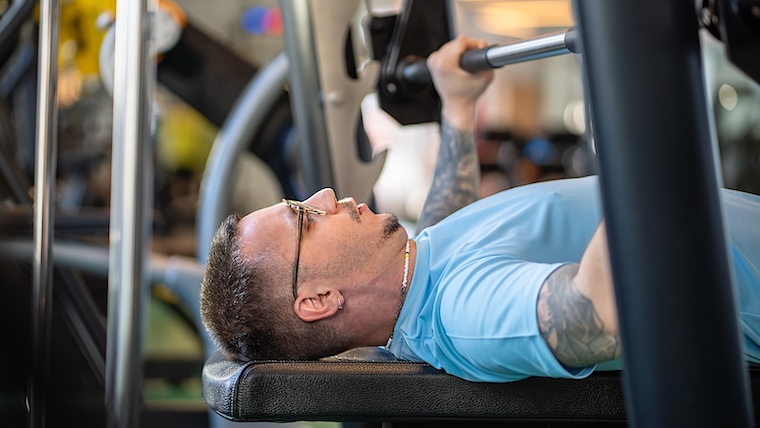Is pushing beyond training limits the key to faster muscle gains? Are partial reps better than a full range of motion? In April 2025, the House of Hypertrophy (HoH) shared an analysis of studies comparing the hypertrophic effects of forced reps, post-failure partials, and different ranges of motion.
With post-failure partials, the lifter squeezes as much motion as possible after failing to complete full reps. Partial reps can be performed at the top or bottom of the rep; the former trains the muscle in its shortened position, the latter in the lengthened position.
Some exercises, like chest flyes, are most challenging in the stretched position, while others, like calf raises and rows, are harder during contractions. Some research indicates the stretch is slightly more growth-promoting for specific muscles, suggesting lengthened partials might be more beneficial.
What Studies Revealed
A 2024 study showed greater medial gastrocnemius (part of the largest calf muscle) growth with post-failure lengthened partials versus full-range calf raises. (1) There’s a twist, however, as lengthened partials grew the overall gastrocnemius better than full reps, and shortened partials in another study. (2) Both involved untrained volunteers.
Based on these findings, lengthened partials are more efficient during calf raises.
A recent 2025 study of 23 trained participants, averaging 7.3 years of lifting experience, compared post-failure partials to lengthened partials during Smith machine calf raises. Subjects performed post-failure partials with one leg and lengthened partials with the other; four sets per session, two times weekly for eight weeks. (3)
The training loads were adjusted so that sets were taken to failure in the 10-to-20 rep range.
Despite reaching failure twice during each set of post-failure partials, lengthened partials still produced more muscle growth. The study was limited due to a small sample size, high measurement error, and the subjects typically training calves with low volume.
The previously cited papers showed compelling evidence to recommend lengthened partials.
Muscle Mechanics
A possible reason why lengthened partials outperformed other techniques is that the calves generate more tension at longer lengths.
Post-failure partials involve a greater proportion of time at shorter lengths, where contractile tension is lower.
Skipping the shortened range during calf raises might be more productive.
Is This True for All Muscles?
This is not necessarily true for all muscles as other studies show mixed results with the limited data. In several experiments, stretch-biased variations produced significantly more growth than concentric-biased movements and full reps. (4)(5) Conversely, bench pressing may not benefit from lengthened partials, as it’s most difficult in the lengthened position.

Though there’s no proof, lengthened partials may only be superior to full reps with more challenging concentrics. Additionally, some research indicates that lengthened partials grow specific parts of muscles better during certain exercises.
Training Recommendations
- Calf training: Lengthened partials appear more efficient.
- Other muscles: Prioritize full range of motion and experiment with lengthened partials.
- Post-failure partials: May help push limits.
Based on these findings, lengthened partials are worth adding to your training toolkit, especially for specific exercises. Individual results may vary.
More In Research
References
- Kassiano W, Costa B, Kunevaliki G, Soares D, Zacarias G, Manske I, Takaki Y, Ruggiero MF, Stavinski N, Francsuel J, Tricoli I, Carneiro MAS, Cyrino ES. Greater Gastrocnemius Muscle Hypertrophy After Partial Range of Motion Training Performed at Long Muscle Lengths. J Strength Cond Res. 2023 Sep 1;37(9):1746-1753. doi: 10.1519/JSC.0000000000004460. Epub 2023 Apr 3. PMID: 37015016.
- Maeo S, Wu Y, Huang M, Sakurai H, Kusagawa Y, Sugiyama T, Kanehisa H, Isaka T. Triceps brachii hypertrophy is substantially greater after elbow extension training performed in the overhead versus neutral arm position. Eur J Sport Sci. 2023 Jul;23(7):1240-1250. doi: 10.1080/17461391.2022.2100279. Epub 2022 Aug 11. PMID: 35819335.
- Pedrosa GF, Lima FV, Schoenfeld BJ, Lacerda LT, Simões MG, Pereira MR, Diniz RCR, Chagas MH. Partial range of motion training elicits favorable improvements in muscular adaptations when carried out at long muscle lengths. Eur J Sport Sci. 2022 Aug;22(8):1250-1260. doi: 10.1080/17461391.2021.1927199. Epub 2021 May 23. PMID: 33977835.
Featured image via Shutterstock/DimaBerlin